
The United States Navy Sea, Air, and Land (SEAL) Teams, commonly known as Navy SEALs, are the U.S. Navy's primary special operations force and a component of the Naval Special Warfare Command. Among the SEALs' main functions are conducting small-unit special operation missions in maritime, jungle, urban, arctic, mountainous, and desert environments. SEALs are typically ordered to capture or kill high-level targets, or to gather intelligence behind enemy lines. SEAL team personnel are hand-selected, highly trained, and possess a high degree of proficiency in unconventional warfare (UW), direct action (DA), and special reconnaissance (SR), among other tasks like sabotage, demolition, intelligence gathering, and hydro-graphic reconnaissance, training, and advising friendly militaries or other forces. All active SEALs are members of the U.S. Navy.

USS Grayback (SS/SSG/APSS/LPSS-574), the lead ship of her class of submarine, was the second ship of the United States Navy to be named for the grayback.

A dry deck shelter (DDS) is a removable module that can be attached to a submarine to allow divers easy exit and entrance while the boat is submerged. The host submarine must be specially modified to accommodate the DDS, with the appropriate mating hatch configuration, electrical connections, and piping for ventilation, divers' air, and draining water. The DDS can be used to deploy a SEAL Delivery Vehicle submersible, Navy divers, or Combat Rubber Raiding Craft (CRRC).
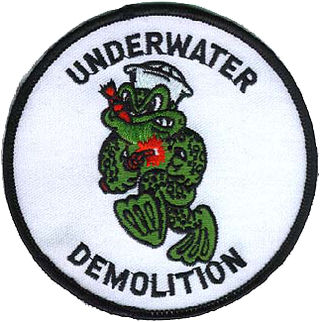
The Underwater Demolition Team (UDT), or frogmen, were amphibious units created by the United States Navy during World War II with specialized missions. They were predecessors of the Navy's current SEAL teams.

The SEAL Delivery Vehicle (SDV) is a crewed submersible and a type of swimmer delivery vehicle used to deliver United States Navy SEALs and their equipment for special operations missions. It is operated by SEAL Delivery Vehicle Teams.

The United States Naval Special Warfare Command (USNSWC), also known as NAVSPECWARCOM and WARCOM, is the naval component of United States Special Operations Command, the unified command that oversees and conducts the nation's special operations and missions.
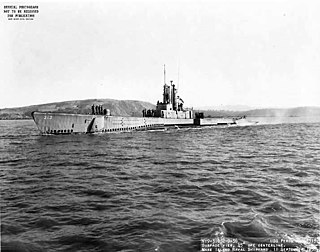
USS Perch (SS/SSP/ASSP/APSS/LPSS/IXSS-313), a Balao-class submarine, was the second submarine of the United States Navy to be named for the perch, a freshwater spiny-finned fish.
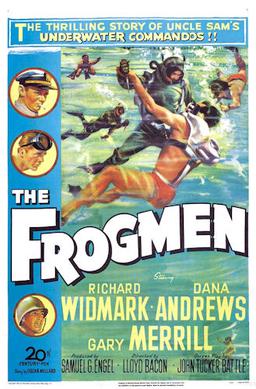
The Frogmen is a 1951 American black-and-white World War II drama film from Twentieth Century Fox, produced by Samuel G. Engel, directed by Lloyd Bacon, that stars Richard Widmark, Dana Andrews, and Gary Merrill. The film's storyline is based on operations by United States Navy Underwater Demolition Teams, popularly known as "frogmen", against the Japanese Army and naval forces. It was the first such film about scuba diving and became a popular cultural hit.

The Advanced SEAL Delivery System (ASDS) was a midget submarine operated by the United States Navy and United States Special Operations Command. It provided stealthy submerged transportation for United States Navy SEALs from the decks of nuclear submarines for use as an insertion platform for covert and clandestine special operations missions. The ASDS was canceled in 2009 due to cost overruns and reliability issues, after the prototype was destroyed in a fire in 2008. As of 2019, the Navy plans to replace the ASDS with the Dry Combat Submersible, a similar midget submarine being developed by Lockheed Martin.

A wet sub is a type of underwater vehicle, either a submarine or a submersible, that does not provide a dry environment for its occupants. It is also described as an underwater vehicle where occupants are exposed to ambient environment during operations. The watercraft is classified as medium-sized or small vessel. This type of submarine differs from other underwater personal transport devices by the fact that it has a hull around it and it is not a "bare bones" design.

Michael Patrick Murphy was a United States Navy SEAL officer who was awarded the U.S. military's highest decoration, the Medal of Honor, for his actions during the War in Afghanistan. He was the first member of the United States Navy to receive the award since the Vietnam War. His other posthumous awards include the Silver Star Medal and the Purple Heart.
Naval Special Warfare Group 3 (NSWG-3), based at the Naval Amphibious Base Coronado in California, was one of six constituent formations of the United States Naval Special Warfare Command. Until 2008, NSWG-3 was composed of two SEAL Delivery Vehicle Teams: SDVT-1 in Pearl Harbor and SDVT-2 in Little Creek. In 2008, SDVT-2 was disestablished and merged into SDVT-1, which was then now headquartered in Pearl Harbor and operated detachments in Pearl Harbor and Little Creek. SDV Teams are SEAL teams with an added underwater delivery capability. SDVT-2 was reactivated on 8 March 2019. NSWG-3 was deactivated alongside NSWG-10 in August 2021 and replaced by Naval Special Warfare Group 8 which took in all units previously under NSWG-3 and NSWG-10.

The US employs divers in several branches of the armed forces, including the navy, army, marines, air force and coast guard.
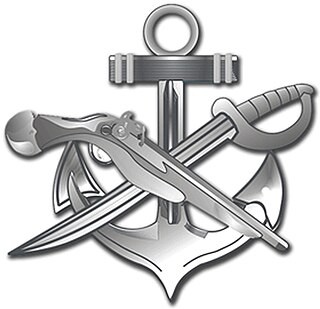
The Special Warfare Combat Crewmen (SWCC ) are United States Naval Special Warfare Command personnel who operate and maintain small craft for special operations missions, particularly those of U.S. Navy SEALs. Their rating is Special Warfare Boat Operator (SB).

Helicopter Sea Combat Squadron 84 (HSC-84) "Red Wolves" was a helicopter squadron of the United States Navy Reserve. Along with the "Firehawks" of HSC-85, the "Red Wolves" were one of only two squadrons in the U.S. Navy dedicated to supporting Navy SEAL and SWCC Teams, and Combat Search & Rescue. Prior to their deactivation in March 2016 they operated 14 HH-60H Rescue Hawks organized into four independent, two aircraft detachments that could deploy anywhere in the world within 72 hours of notice.
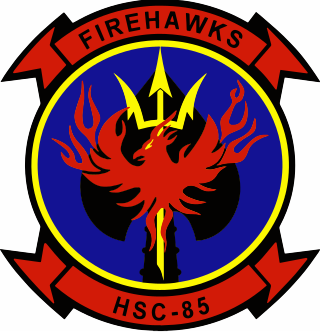
Helicopter Sea Combat Squadron EIGHT FIVE (HSC-85) was a United States Navy Reserve forces helicopter squadron (RESFORON) based out of Naval Air Station North Island in San Diego, California. The "FIREHAWKS" of HSC-85 are Reserve and Active Component Sailors who operate and maintain Sikorsky MH-60S Seahawk helicopters.

Helicopter Sea Combat Squadron 12 (HSC-12)Golden Falcons is a United States Navy helicopter squadron formerly designated HS-2, based at Naval Air Facility Atsugi, in Japan. They are attached to Carrier Air Wing Five with the aircraft carrier USS Ronald Reagan.

The Republic of Korea Navy Special Warfare Flotilla is a special operations force of the Republic of Korea Navy. The WARFLOT is most commonly referred to as the Underwater Demolition Team or UDT, and sometimes as UDT/SEALs, coming from the fact UDTs are the most prominent branch of the flotilla and their close ties with US Navy SEALs respectively.
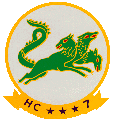
Helicopter Combat Support Squadron Seven (HC-7) was a helicopter squadron of the United States Navy established on 1 September 1967 and disestablished on 30 June 1975.

Helicopter 66 was a United States Navy Sikorsky Sea King helicopter used during the late 1960s for the water recovery of astronauts during five missions of the Apollo program. It has been called "one of the most famous, or at least most iconic, helicopters in history", was the subject of a 1969 song by Manuela, and was made into a die-cast model by Dinky Toys. In addition to its work in support of NASA, Helicopter 66 also transported the Shah of Iran during his 1973 visit to the aircraft carrier USS Kitty Hawk.


















